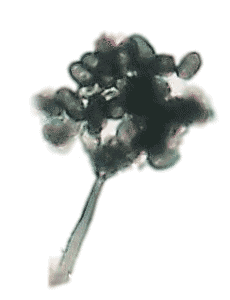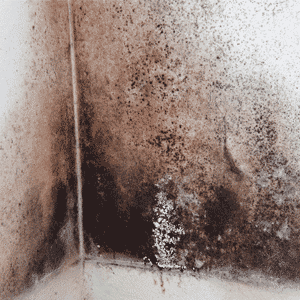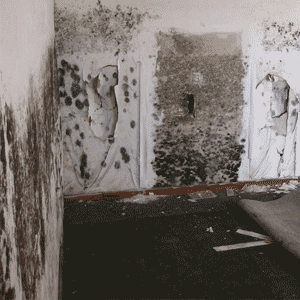
More Articles
Under normal conditions, Stachybotrys is found in soil, on decaying plant materials (substrates), decomposing cellulose (hay and straw), leaf litter and seeds.
Indoors Stachybotrys grows on wet materials containing cellulose like drywall paper, wicker and straw materials. Drywall paper is the most plentiful material where Stachy is often found. It is a later invader, relatively slow grower and requires high water content. Following Penicillium/Aspergillus types and Cladosporium, Stachy will often overgrow these molds over a long enough period of time if there is sufficient water content.

The popular press heralds the dangers of “Toxic Molds” particularly Stachybotrys. This is the infamous “black mold” that appears to have terrorized many who live or work in an environment plagued by moisture intrusion. According to some very respected researchers, the belief that exposure by inhalation to mycotoxins (toxins produced by molds) produces a wide variety of symptoms is not supported by scientific evidence. Yet the mention of Stachybotrys often brings a response or at least brings to mind, “black mold” or “killer mold.” Certainly, Stachybotrys is the most notorious of molds. It is capable of producing toxins, but that doesn’t mean it’s “out to get ya.” The toxins produced by molds only have the purpose of destroying molds that have already taken up residence in a location and claiming that food source or to keep other molds from invading. That the toxins might also have adverse effects on humans would be purely coincidental.
Being the most notorious of the potential toxin-producing molds puts Stachybotrys in the middle of a major controversy in the indoor air quality community. While many in the public have become concerned with exposure to mold toxins, it has never been clinically proven that inhalation of mold spores containing mycotoxins (mold toxins) can result in human illness. The major discrepancy is that according to major mycologists and microbiologists, it is impossible to inhale enough toxins to be harmful. The controversy is between the clinical practitioners and those working in the field. Field evidence is anecdotal in that people chronically exposed to mold toxins exhibit a variety of health symptoms. This is especially the case when it is found inside bedroom walls. The illnesses appear to be well beyond allergy reactions that are acknowledged as the only health effects possible except in the case of actually pathogenic molds.

The most significant incident launching the names “Toxic Mold,” “Black Mold,” “Killer Mold” and Stachybotrys into the public vernacular was the death of several young children with symptoms including pulmonary bleeding. These deaths that occurred in a Cleveland, Ohio inner- city neighborhood were closely connected with exposure to Stachybotrys. Recent studies by the Center for Disease Control (CDC) have essentially rescinded that judgment (see my article, “Taming the Wild Debate over the Health Effects of Mold Exposure.”) The CDC’s conclusion, in a nutshell, was that Stachybotrys exposure has not been proven to be the cause of the pulmonary bleeding that accompanied the infants’ deaths.
What has not been addressed in this CDC study is that the immune system of a young child is not fully developed making them more susceptible to toxic or pathogenic invaders. Stachybotrys has been shown to suppress the immune system. Several Aspergillus species are known to be pathogenic with pulmonary bleeding (coughing up blood) being one of the major symptoms. Aspergillus is often found growing on the same substrate as Stachybotrys. In combination, the two mold types could very well result in the kind of symptoms reported.
Becoming known as the “black mold” brought more mystery to Stachybotrys by becoming loosely attached to the “mummy curses.” Interest in the curses received impetus with the publicity in the last 20 or so years of discoveries in the tomb of “King Tut.” References to black mold as a more scientific explanation for some mysterious deaths of people involved with pyramid excavation insinuated Stachybotrys as the likely culprit. The black mold involved was more likely Aspergillus niger, which is a black mold that is pathogenic. Never-the-less Stachy has become synonymous with “Black mold.” Certainly, mold exposure in these burial locations is not unlikely due to the organic material inside the burial chamber including the body or bodies plus the foodstuffs expected to last them the trip to the afterlife. Illness and even death might have resulted in some cases especially with immune impaired individuals. As with the case in the Cleveland inner city incident, Stachybotrys might have been involved, but not necessarily the primary cause.

What's the harm?
While certain individuals can develop allergies to virtually any mold, allergies to Stachybotrys are not well studied. Stachy potentially produces a long list of toxins. There are many human reports of toxicosis due to Stachybotrys exposure, but these are anecdotal and currently being researched. Certainly, Stachybotrys is the most notorious of the potentially toxic molds. There are no reports of human infections.
A wide variety of symptoms are reportedly related to Stachybotrys exposure. Keep in mind that actual symptoms as well as how debilitating the symptoms might be can vary significantly from one person to another. The list of symptoms below should be considered “including but not limited to.”
Mental and neurological symptoms:
including dizziness, anxiety hallucinations and depression.
Respiratory symptoms:
including difficulty breathing, coughing, runny nose, and nose bleeds
Circulatory symptoms:
including irregular heartbeat, low blood pressure and heart inflammation.
Vision and eye problems:
including eye damage, blurry vision, and eye inflammation.
Skin problems:
including dermatitis, crawling skin, and jaundice.
Immune system problems:
including immune system
Reproductive system problems
including infertility, miscarriage, and impotence.
Tiredness and discomfort:
including chronic fatigue, muscle pain, joint pain, headaches, fever, and nausea






